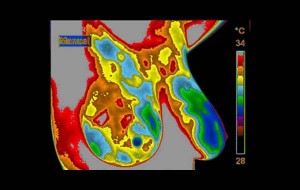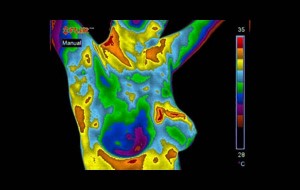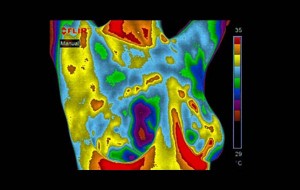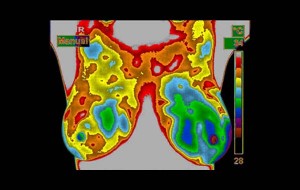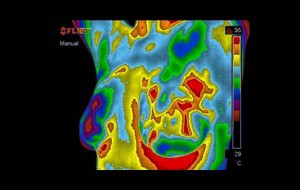Studies show that an abnormal infrared image is the single most important marker of high risk for developing breast cancer, ten times more significant than a family history of the disease. Women with persistent abnormal thermograms could be at a significantly higher risk for future breast cancer based on their own physiology.
According to the International Academy of Clinical Thermology, “Breast thermography is a thermovascular detection procedure that images the breasts to aid in the early detection of breast cancer.”
It is an invaluable tool used to monitor breast health, specifically identifying abnormal physiology indicating possible risk factors for the development or existence of cancer. This is a non-invasive procedure that uses no radiation or compression to the breast and is a valuable adjunct to self-examination and mammography or other structural imaging.
With annual thermographic imaging, physiology of the breast can be monitored year over year to evaluate a woman’s risk for developing breast cancer.
How is it different than a mammogram? Does it replace a mammogram?
Again, Thermograms are an adjunct procedure. Women should be knowledgeable of the tools available to them to monitor their breast health and Thermography can be used safely as often as necessary. Thermograms look at the physiology, or normal functioning, of the breast, while structural imaging, like mammograms, looks at the anatomy of the breast. Thermograms, self-examination and age-appropriate structural imaging should be included in a woman’s normal routine for prevention.
What age should women consider getting a thermogram?
Women of any age can have a thermogram and they are recommended for women beginning at age 20. New guidelines recommend mammograms or other structural imaging beginning at age 50, or earlier if there are known risk factors. Thermograms offer a way for younger women to monitor their breast health. There are no risks associated with the imaging and they are especially helpful when there is dense tissue.
What are the benefits of thermography?
Thermography offers women of all ages the ability to investigate their risk for developing breast cancer. It offers the opportunity of earlier detection than has been possible through breast self-examination or mammography alone. Thermography also offers a way of looking at the health of the breast that is different from the anatomical view that structural imaging provides.
 Is thermography safe?
Is thermography safe?
Thermography is completely safe. Thermographic imaging uses no radiation and there is no direct contact (no compression) of the breast. There are no side effects from thermography, it is essentially no different than having your picture taken with a digital camera.
Thermographic equipment is FDA registered, and the International Academy of Clinical Thermology sites over 800 peer-reviewed breast thermography studies in the index-medicus, which have been studied over the last 30 years. The technology has improved considerably over the years, and it remains a safe and painless procedure in preventative health.
What is the doctor looking for when he interprets the scans?
The doctor is analyzing the breasts for 22 different vascular and thermal factors. The simplest of which is comparing one breast to the other looking for blood vessel and heat asymmetries. Once detected and analyzed, each breast is graded and classified into one of five TH (Thermo-biological) levels.
Women of all ages can and should use the tools available to them in their preventative health routine. A simple, yet crucial, recommendation is to be informed. Educate yourself regarding your health. Knowledge is power. Understand how and which environmental exposures and food choices impact your risk factors. Learn how to make better choices daily. Illness happens over time and we have power to improve our health – power that comes only from knowledge.
For more information on our Full Body Thermography services - click here


